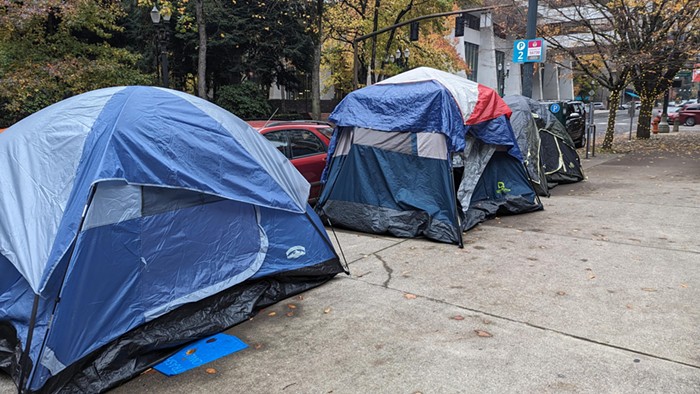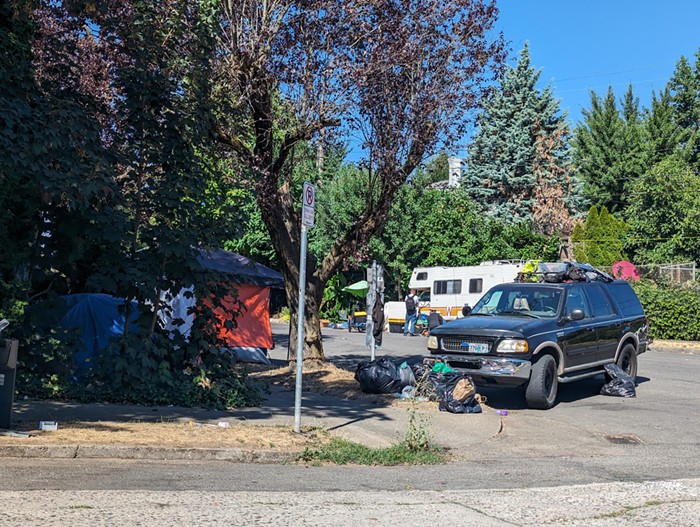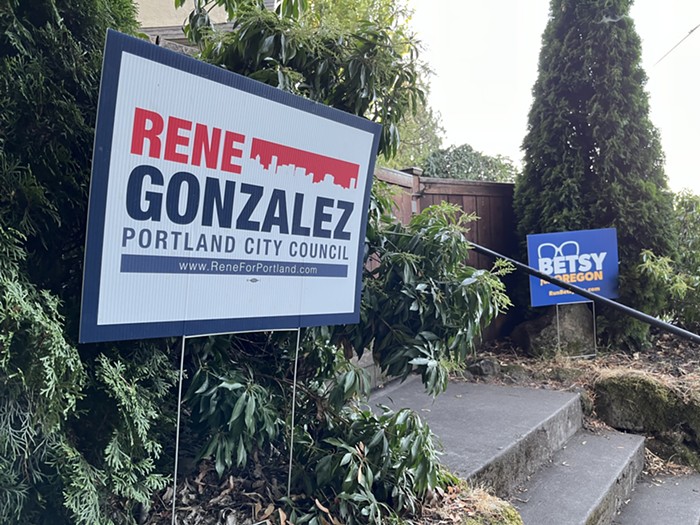When Lisa Woods reminisces about her daughter Nikki Kuhnhausen, one story makes her especially proud.
Kuhnhausen was one of a handful of transgender high school students at Hudson’s Bay High School in Vancouver, Washington between 2015 and 2019. She was known for being tough, and often got disciplined at school for fighting with other students who picked on her or a friend. One day in her sophomore year, she saw a younger trans student crying outside the women’s restroom. Other teens had kicked the student out.
“Nikki demanded their names,” says Woods, speaking at her home in a heavily forested neighborhood in Vancouver. Woods is a middle-aged woman with wavy blonde hair and sad eyes, though they perk up when she recounts this story. “She went and got them and made them apologize,” says Woods, who adds that the student was never bullied again. “[They were] safe with Nikki around.”
This is one of many memories Woods has returned to since December 7, 2019, when the Vancouver Police Department told her Kuhnhausen had been murdered in what officers believed was an act of anti-trans violence. Kuhnhausen, who was 17 years old at the time of her death, was one of at least 26 trans women to be murdered in the United States last year.
“She was never afraid to be Nikki,” Woods says. “I fear that’s a part of the reason why she got killed, because she didn’t think anybody would hurt her.”
Kuhnhausen’s sudden, cruel death has left her friends, family, and members of the LGBTQ+ community, in deep mourning. It’s also served as a call to action. Less than a month after her death, a group called Justice for Nikki is working to pass a state bill that would ensure the kind of transphobia that cost her life—and the lives of dozens of trans women across the country—won’t be tolerated in Washington’s legal system.
For Woods, this work is a fight to make sure her daughter’s death was not entirely in vain. It’s also a lifeline of hope during the darkest experience of her life.
“These people are coming out of the woodwork for Nikki, some who haven’t even met her,” says Woods, tearing up. “It’s her guiding me. It’s her strength that I’m drawing from because I just want her to be proud of me.”
Kuhnhausen was assigned male when she was born on July 6, 2001. From an early age, it was apparent she might not fit with that gender designation, as evidenced in photos of Kuhnhausen around age five. In one, she’s wearing a long platinum-blonde wig she dug out of her mom’s friend’s closet. In another, she’s holding up an arm covered in a bright pink cast, a color she chose after falling off the monkey bars when playing with one of her two older brothers. In both photos, Kuhnhausen is grinning from ear to ear.
“Her brothers were so mad when she came home with this pink cast,” Woods recalls. “They were like, ‘Why did you get pink?’ But that’s what color Nikki wanted.”
Woods never tried to redirect Kuhnhausen to traditionally masculine interests. Instead, Woods let her experiment with her makeup, idolize girl characters on Hannah Montana, and play dress-up with Disney princess dresses in her room. When she outgrew the costumes, Woods bought Kuhnhausen clothes from the girls’ section in department stores. When Kuhnhausen began fitting into Lisa’s high-heeled shoes, she’d wear them while shooting hoops with her brothers.
“It’s her strength that I’m drawing from, because I just want her to be proud of me.”—Lisa Woods, Nikki Kuhnhausen's mother
Kuhnhausen’s parents split up when she was a small child, but both parents agreed to support their child in her exploration of gender. Relatives would sometimes question their parenting decisions, warning that Kuhnhausen would “turn into a girl.” But Woods says she’d wave them off, telling them, “I’m not turning her into anything. She’s choosing this, and I don’t see anything wrong with this.”
Kuhnhausen presented as a boy while attending elementary school, where she won medals for running hurdles in track. It wasn’t until middle school when she began presenting as a girl in public.
“She started off slowly... at first she would still wear boy clothes,” remembers Taylor Watts, Kuhnhausen’s close friend since around age 10. “I guess eighth grade year is when she really started transitioning and changing. But she didn’t really change—she was always more girly, more feminine.”
While Kuhnhausen didn’t talk a lot about being transgender, she would never shy away from questions kids asked her at the bus stop. “She didn’t hide it at all,” Watts says.
Bubbly and outspoken, Kuhnhausen dreamt of being a makeup artist or clothing designer for stars like Nicki Minaj, her favorite rapper. In her teens, Woods stopped buying her expensive clothing and opted for cheaper pieces, because she knew Kuhnhausen would cut them up to replicate the distressed look found in high-end fashion. Her aesthetic talent won her approval from the “popular girls,” Woods says.
“The cheerleaders thought she was so beautiful, and her makeup was done so well,” she adds. “They wanted to learn how.”
But not everyone at school was so accepting of Kuhnhausen’s identity. She would sometimes get bullied, and when that happened, she wouldn’t hesitate to physically defend herself. She did the same for other kids who were targeted.
“She fought for her respect,” Woods says. “She didn’t play around.”
Kuhnhausen’s assertiveness is on display in one of the hundreds of videos she uploaded to the app TikTok. Kuhnhausen, her eyes emphasized with bold eyeliner, delivers a diatribe against people who say, “You don’t need all that makeup, you’re beautiful just how you are.”
“First of all, I already knew that,” she says sharply, the video jump-cutting to different angles every few seconds in TikTok’s signature style. “And second, assuming someone’s only wearing makeup because they’re insecure—that’s not a compliment!”
During her teen years, Kuhnhausen spent more time at her father’s house than with Woods, and eventually started staying at different friend’s houses most of the time. Woods, who was struggling to treat a mental illness, says she wasn’t always able to be there for Kuhnhausen the way she wanted. But the two always stayed in close communication, serving as support systems for each other.
The pair would frequently talk on the phone before Woods began her morning shifts as a cashier at Walmart. So when Kuhnhausen didn’t answer a scheduled phone call the morning of June 6, 2019, Woods immediately knew something was off. Her worries grew as messages she sent Kuhnhausen through Facebook Messenger were never marked as “seen”—which would have indicated that Kuhnhausen had read them—over the next couple days. Kuhnhausen’s older brother also grew concerned when he didn’t hear from her, because she usually called him every other day to check on her two-year-old niece, on whom she doted.
On June 10, Woods reported her daughter as missing to the police.
After an agonizing six-month period of waiting and hoping Kuhnhausen would turn up, three Vancouver police detectives arrived at Woods’ home on December 7.
“That morning, I had made homemade Christmas cards,” Woods remembers. “And I made her one, because I thought she was going to be home. I really did.”
She could see the detectives approach through the windows by her front door, and immediately fell to the floor and started sobbing. She knew what they were there to tell her: Her daughter was dead.
Detectives explained that a hiker had come across Kuhnhausen’s skull earlier that day on Larch Mountain, a natural area that’s a 50-minute drive northeast of Vancouver, and alerted police. Ten days later, they arrested 25-year-old David Bogdanov for Kuhnhausen’s murder. She was 17 at the time of her death.
Police reports and court records tell the story of what detectives believe happened between Kuhnhausen and Bogdanov. Based on cell phone data and witness evidence, detectives believe Bogdanov and Kuhnhausen met while Bogdanov was driving around the streets of Vancouver the evening of June 6, and that Bogdanov gave Kuhnhausen alcohol. He later dropped her off at a friend’s house in Vancouver, but soon reconnected with her over Snapchat. Police believe Bogdanov picked her back up and with the intention of having a “sexual encounter”—and then Kuhnhausen told him that she was transgender.
In police interviews, Bogdanov admitted to meeting with Kuhnhausen and becoming “really, really, disturbed” when he learned she was trans. But Bogdanov maintains that Kuhnhausen got out of his car and walked away at that point, and that he did not harm her.
Detectives aren’t convinced. Based on forensic evidence, cell phone data, and Bogdanov’s own words, they believe he killed Kuhnhausen after learning she was trans.
“David became enraged at the realization he had engaged in sexual contact with [a trans woman],” the police detective’s report reads, “and strangled Nikki to death.”
After he allegedly killed Kuhnhausen, detectives believe Bogdanov drove to Larch Mountain and left her remains on a “steep, densely wooded embankment” off the side of the road.
Bogdanov pled “not guilty” to the murder in December and is currently out on $750,000 bail—a decision by Clark County Judge David Gregerson that Woods calls “very unjust,” given that bail for other murder and attempted murder cases in Clark County can reach millions of dollars. The trial is set to begin in July.
The prosecution’s case will likely hinge on the premise that Bogdanov killed Nikki after learning she was trans, which explains why an accusation of a hate crime has been added to his charges. But, because of the way Washington and others state courts perceive this kind of crime, this could be the same argument Bogdanov’s lawyers use in their client’s defense.
The LGBTQ+ panic defense—also often called the gay-panic or trans-panic defense—is a legal strategy which argues that learning a person is trans or queer during a social or sexual encounter could excuse someone’s murder or assault. Defense attorneys usually present the argument in one of two ways: It is either argued that the revelation someone is LGBTQ+ can be so upsetting for someone that they become temporarily incapacitated and cannot be fully held responsible for their violent actions during that time; or lawyers contend that knowing someone is queer or trans is enough to suspect they might try to commit sexual assault, and any violent actions are done in self-defense. First documented in the 1950s and used as recently as 2018, the LGBTQ+ panic defense is sometimes successful in acquitting alleged murderers and assaulters or reducing the severity of their charges.
“It works routinely,” says D’Arcy Kemnitz, executive director of the National LGBT Bar Association. “It works because it plays on the worst stereotypes that LGBTQ+ people are somehow predatory.”
A legal brief from the Williams Institute at the University of California, Los Angeles found documented cases of the LGBTQ+ panic defense being used in 23 US states at least once. The brief didn’t identify known cases in Oregon or Washington, but Kemnitz says the actual numbers are likely higher. She says it’s hard to track these cases because they’re not all highly publicized, and because the defense can also be used behind closed doors to reduce charges in a plea deal.
In 2013, the American Bar Association passed a resolution written by the National LGBT Bar Association, urging states to outlaw the defense.
California had been the first state to do so in 2006 when it passed the Gwen Araujo Justice for Victims Act, named after a trans teenager who was murdered in 2002. One of Araujo’s killers used the trans-panic defense in trial, and it was effective enough to result in a hung jury. He was later convicted on reduced charges in a second trial.
The LGBTQ+ panic defense is now outlawed in nine states, but Washington and Oregon aren’t among them. It’s not yet known whether Bogdanov’s defense team will use the LGBTQ+ panic as a legal strategy—as of now, he maintains he did not kill Kuhnhausen—but there is nothing legally stopping them.
Mikki Gillette of Basic Rights Oregon, a nonprofit that advocates for LGBTQ+ rights, has been providing support and resources for Woods since Kuhnhausen’s death. Gillette says the LGBTQ+ panic defense reflects the broader cultural belief that “a violent reaction is considered somehow a natural reaction” toward LGBTQ+ people, and trans women in particular. Kuhnhausen’s death, Gillette says, “shows that line of thinking is still alive in our region.”
Legislation outlawing the defense was introduced in the Washington state legislature in 2019 by then-Rep. Derek Stanford, but it never made it to a House vote. Rep. Sharon Wylie, a Democrat who represents Vancouver, reached out to Kuhnhausen’s family after news broke of the murder. She is now making it her goal to get the bill Stanford introduced passed during the current 2020 session, with one amendment: naming it Nikki’s Law, and declaring the day it passes to be Nikki Kuhnhausen Day.
Wylie tells the Mercury she expects Nikki’s Law to pass. She’s hopeful that it will gain bipartisan votes.
“I talked to some of my colleagues across the aisle,” she says. “Once they understand what we’re trying to do, they say they’ll support it.”
Devon Rose Davis, a social worker in Portland, has been providing support for Woods and advocating for Nikki’s Law. A trans woman in her 30s, Davis says her early years were a lot like Kuhnhausen’s, and many trans women she knew then were murdered, disappeared, or died by suicide or drug overdose. She credits strong role models at work with helping her succeed in life, but also says her fate could have been similar to Kuhnhausen’s.
“I want to copyright what the mixture of ingredients is [that helped me survive],” Davis says, “so I can hand it out to people.”
Davis isn’t sure how effective legislation like Nikki’s Law will be in protecting trans lives, considering that transphobia is still deeply rooted in American culture. But she’s glad it could be passed this year.
“If you look at the socio-cultural pieces that are attached to men who commit crimes like this, I don’t know that the fear of losing a defense like this makes a difference to whether those crimes are perpetrated,” she says. “However, it sure makes a difference to Lisa Woods. ...If we look at this not just from a perspective of criminal justice but justice for a person, it seems like the only thing that we can do.”
Working on Nikki’s Law and meeting with other trans kids and their families has helped keep Woods afloat during an intense grieving process—one that has tested her strong Christian faith, her desire to eat or drink water, and her ability to get out of bed in the morning. Old photos, stuffed animals, and cards Kuhnhausen wrote help her feel close to her daughter. She keeps a greeting card teenaged Kuhnhausen gave her once for no reason in particular: “My beautiful Mommy,” it reads. “I (excuse my language) fucking love you!”
Woods also leans on Detective David Jensen, who worked on Nikki’s case and has provided emotional support since Nikki went missing.
“Sometimes I think Dave’s gonna call and say the DNA test was wrong,” Woods says quietly. “So I sleep with my phone just in case. But he hasn’t so far.”
A memorial service will be held for Kuhnhausen at Clark College on March 1. Woods plans to play some of her daughter’s favorite songs at the service, including “Born This Way” by Lady Gaga and “Moment for Life” by Nicki Minaj.
“If we look at this not just from a perspective of criminal justice but justice for a person, it seems like the only thing that we can do.”—Devon Rose Davis
This memorial won’t be the first time people have gathered to remember Kuhnhausen. Community members organized two separate vigils for Nikki in December, shortly after her death was made public—one at a church in Vancouver, and one on the waterfront in downtown Portland. Davis, the social worker who has been helping Woods, remembers that despite it being held on a “bone-drenching wet” day, more than 100 people showed up to the Portland vigil.
“Half of that vigil was people talking, and then the other half was Lisa going around and hugging everyone that came and thanking them for showing up,” she says.
The Portland vigil was organized by the same trans teenager whom Nikki had defended after they were kicked out of the bathroom in high school.
“It was a really beautiful full-circle thing,” Davis says. “The person who was taken care of by Nikki then shows up to take care of Nikki.”




















